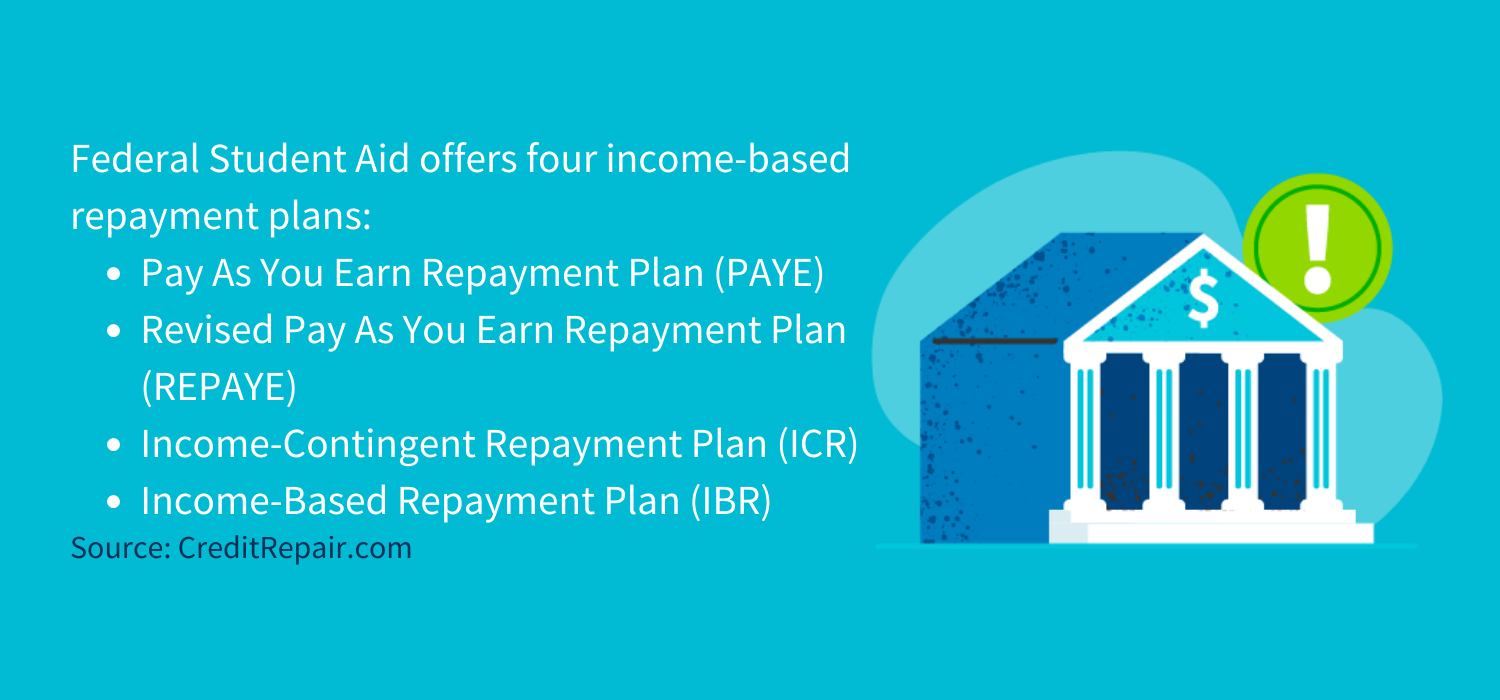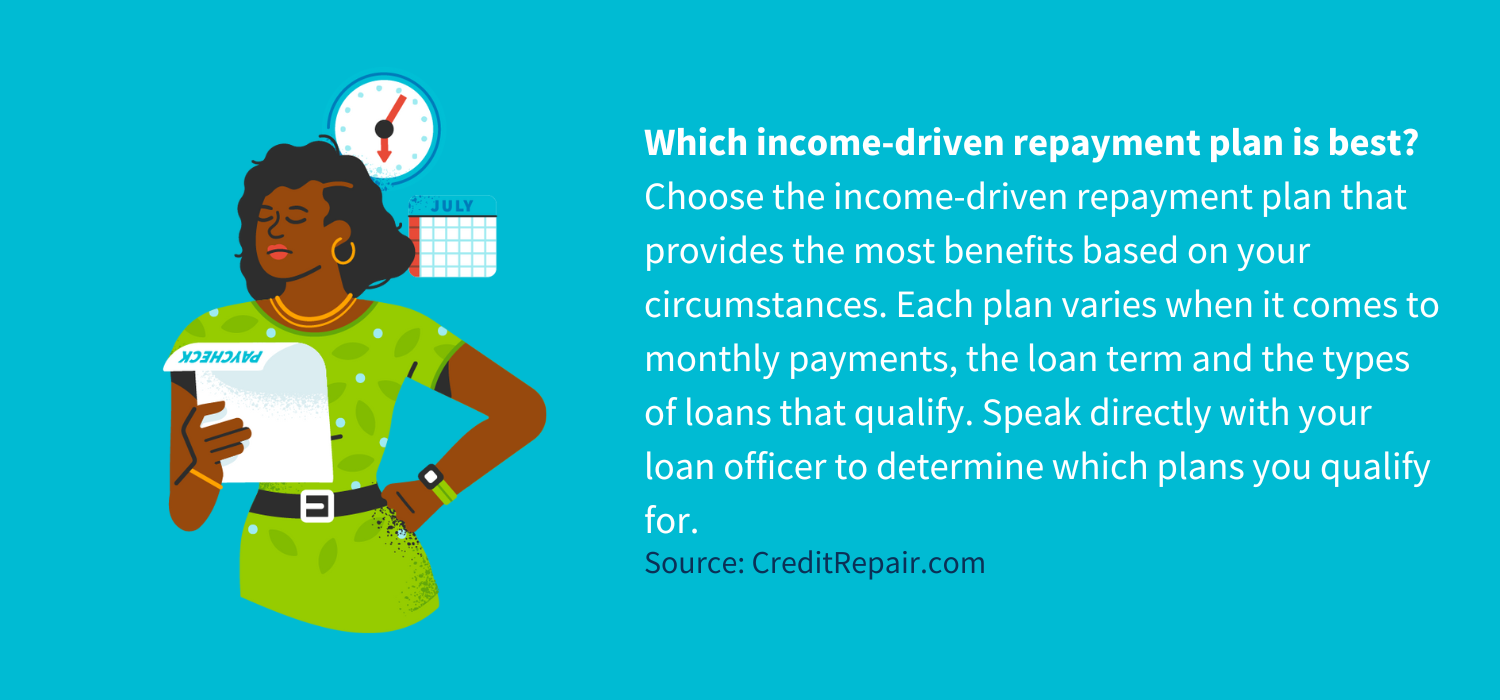
Disclosure regarding our editorial content standards.
If student loans feel like the barrier between a healthy financial future and where you are now, you’re not alone. The Federal Student Aid reported 11.5 million people with outstanding Federal Family Education Loans (FFEL) alone as of Q2 2020. Luckily, federal student loans come with options for managing your debt. A popular option among student loan recipients is income-driven repayment.
With this type of repayment method, the remaining balance of your debt could be forgiven after the allotted time, but not without you paying income tax on that balance. The question at the forefront of many postgraduates’ minds then is, does income-driven repayment affect my credit score? The program itself does not, but the results of changing your payment structure could come back to haunt you if not managed properly.
What does income-driven repayment mean?
Income-driven repayment (IDR) is a type of plan that reestablishes your student loan payments based on your discretionary income and family size. The payment can increase or decrease annually depending on changes to each of these factors. The remaining balance at the end of the loan is generally forgiven. Keep in mind that you’ll typically pay income tax on the forgiven balance, plus you’ll end up paying a higher interest rate over time because you’re paying a lower amount per month.
There are four types of income-driven repayment plans, including the Income-Based Repayment Plan (IBR Plan), the Income-Contingent Repayment Plan (ICR Plan), the Revised Pay As You Earn Repayment Plan (REPAYE Plan) and the Pay As You Earn Repayment Plan (PAYE Plan). While each program has its own eligibility requirements, most federal student loans qualify for at least one.
Does income-driven repayment affect your credit score? How?
Income-driven repayment doesn’t have a direct impact on your credit score. You aren’t opening a new line of credit or adding another loan. However, it can affect your ability to qualify for new credit cards, loans and lines of credit. This is because it changes the repayment term for your student loans. On a standard repayment plan, the payment term lasts for 10 years. Income-driven plans have terms ranging from 20 to 25 years.
With a longer repayment term, your loan balance doesn’t decrease as fast as it would with the standard term. If you apply for new credit, the lender may deny your application due to the amount of money you owe compared to your original loan balance.
How does income-driven repayment work?

Income-driven repayment works by using your discretionary income and family size to determine your monthly student loan payment. Federal Student Aid offers four income-based repayment plans:
- Pay As You Earn Repayment Plan (PAYE)
- Revised Pay As You Earn Repayment Plan (REPAYE)
- Income-Contingent Repayment Plan (ICR)
- Income-Based Repayment Plan (IBR)
The U.S. Department of Education defines discretionary income as the difference between your annual income and 150 percent of the poverty guideline for your state and family size. You must certify your income each year, so if your income changes, your monthly payment may also change.
Who is eligible for income-driven repayment?
Each repayment plan has its own eligibility requirements. Some require proof of financial hardship, while others are available to all borrowers who meet the other eligibility guidelines. No matter which plan you choose, you must provide proof of your income annually. Any accrued interest on the loan may also be capitalized, which means it’s added to the loan’s principal balance, increasing the total amount you owe.
PAYE
- You must have Direct Loans, which are loans issued directly by the U.S. Department of Education.
- You must provide proof of financial hardship.
- You must have had no outstanding balance on a Federal Family Education Loan or Direct Loan as of October 1, 2007.
- You must have received a disbursement of a Direct unsubsidized, Direct subsidized or Direct Grad PLUS loan on or after October 1, 2011.
REPAYE
- You must have Direct Loans.
- You must renew your REPAYE plan each year. If you don’t, you’ll be placed in the REPAYE Alternative plan.
IBR
- You must have Direct Loans or Federal Family Education loans.
- You must provide proof of financial hardship.
ICR
- You must have Direct Loans
- Does not require financial hardship.
In each case, if you’re filing your taxes jointly with your spouse, their income will also be used to determine the monthly payment.
How do you apply for income-driven repayment?
To apply for income-driven repayment, submit an Income-Driven Payment Plan Request via the Federal Student Aid website.
Income-driven repayment considerations
While lenders typically don’t consider a repayment plan a negative attribute of borrowers, your credit score can be impacted if payments are mismanaged. To improve credit with an income-driven repayment plan, make payments on time every month to get to a debt-free status as quickly as possible.
Before applying for a repayment plan, consider the pros and cons.
Pros:
Lower debt-to-income ratio: Income-driven repayment lowers your monthly payments to reduce your monthly debt-to-income ratio, calculated by monthly debt obligations divided by gross monthly income.
Reduced monthly payments: While IDR lengthens the term of your loan, your monthly payments will be reduced, often to effectively avoid missed payments and lend more financial stability.
Loan forgiveness: After making consistent payments for the entirety of your loan term, the remaining debt can be written off by the creditor, but it will be considered taxable income.
Cons:
Higher interest: Because the loan term is extended between 10 and 20 years, you’ll typically end up paying more in interest over time.
Recertification requirements: Borrowers using IDR plans have to recertify their income and family size every year to remain qualified for the plan. If missed, the monthly payment can increase to its original amount.
Debt term: Because the debt term is a factor that lenders use to qualify borrowers, your chances of getting a new line of credit may be negatively affected for a longer period of time.
What will the payments look like?
Each income-driven repayment plan uses a different method of calculating monthly payments:
- PAYE: Your monthly payment will typically be 10 percent of your discretionary income, but it won’t ever exceed the 10-year Standard Repayment Plan amount.
- REPAYE: Your monthly payment is generally 10 percent of your discretionary income.
- IBR: If you’re a new borrower on or after July 1, 2014, your monthly payment will generally be 10 percent of your discretionary income. If you’re not a new borrower on or after that date, your monthly payment will generally be 15 percent of your discretionary income. Either way, you won’t pay more than the standard 10-year Standard Repayment Plan amount.
- ICR: Your monthly payment will either be 20 percent of your discretionary income or what you would pay on a 12-year fixed payment plan adjusted to match your income (whichever is less).
In each plan, there’s a provision allowing your debt to be forgiven if you continue to make qualifying payments for 20-25 years and still have a balance remaining.

Which income-driven repayment plan is best?
Choose the income-driven repayment plan that provides the most benefits based on your circumstances. Each plan varies when it comes to monthly payments, the loan term and the types of loans that qualify. Speak directly with your loan officer to determine which plans you qualify for.
Because there are four different income-driven repayment options, it’s important to determine which will be the best in your circumstance so you don’t default on your loan—which can be catastrophic to your credit . Many of the plans come with specific requirements, and you’ll want to make sure you requalify annually to remain under the plan. Just make sure to keep an eye on your credit as you move forward with whichever income-driven repayment plan you choose to pursue.
If your credit isn’t where you’d like it to be, consider getting your free online credit report evaluation today at CreditRepair.com.
Note: The information provided on CreditRepair.com does not, and is not intended to, act as legal, financial or credit advice; instead, it is for general informational purposes only.
Questions about credit repair?
Chat with an expert: 1-800-255-0263






